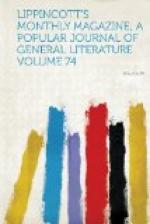Perhaps these thoughts were occupying our minds as we climbed the bluffs for a visit to this incipient Pittsburg. The equipage did no credit to the financial status of the iron company, as it consisted of a superannuated express-wagon drawn by a dyspeptic white horse which the boy who officiated as driver found no difficulty in restraining. Two gentlemen in charge of the constructions, their visitor and two kegs of nails comprised this precious load. The day was cloudless and fine, albeit a Colorado “zephyr” was blowing, and the party, with perhaps the single exception of the horse, felt in fine spirits. The jolly superintendent, who both in face and mien reminded one of the typical German nobleman, was overflowing with story, joke and witty repartee. The site of the works was reached in the course of time. Excavations were in progress for the blast-furnace and accessory buildings, and developed a strange formation. The entire mesa seems built up of boulders packed together with a sort of alkali clay, dry and hard as stone, and looking, as our distingue guide remarked, as though not a drop of water had penetrated five feet from the surface since the time of the Flood. Two blast-furnaces, each with a capacity of five hundred tons, will be speedily built, to be followed by rail-mills, a Bessemer steel-plant and all the accessories of vast iron-and steel-works. With the patronage of several thousand miles of railway already assured, and its duplication in the near future apparently beyond doubt, the success of this daring frontier enterprise seems far removed from the domain of conjecture.
[Illustration: OLD SI SMITH.]
All this was glowingly set forth by the courtly superintendent, who, though but three months in the country, is already at heart a Coloradan. That there are some things about frontier life which he likes better than others he is free to admit. Among the few matters he would have otherwise he gives the first place to the tough “range” or “snow-fed” beef upon which the dwellers in this favored land must needs subsist. “I heard a story once,” said he, “about a young man, a tenderfoot, who, after long wondering what made the beef so fearfully tough, at length arrived at the solution, as he thought, and that quite by accident. He was riding out with a friend, an old resident, when they chanced to come upon a bunch of cattle. The young man’s attention seemed to be attracted, and as the idea began to dawn upon him he faced his companion, and, pointing to an animal which bore the brand “B.C. 45,” savagely exclaimed, ’Look there! How can you expect those antediluvians to be anything but tough? Why don’t you kill your cattle before they get two or three times as old as Methuselah?’”




